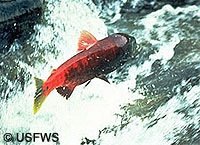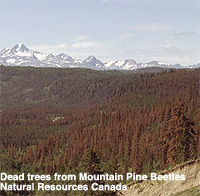
News |
- UK MPs Challenge Climate Change
- BC Sockeye Salmon Runs Endangered
- Red River Nominated as Heritage River
- Mountain Pine Beetle - Havoc in BC Forests
- Grassy Narrows Headed for International Standoff
- Ontario Failing Endangered Species
- Investors Push Climate Change Disclosure
- Manitoba Budget Needs to Support Environment
- Manitoba/US Water Conflicts Escalate
- Ontario First Nation Blockades Exploration
- Record Year for Wind
- Australian Climate Scientists Censored
| UK MPs Challenge Climate Change | 16 March 06 |
 Gavin Strang has become the 50th Member of Parliament in the UK to agree to reduce his carbon emissions by 25 per cent in the next five years, as part of a personal commitment to climate change. Gavin Strang has become the 50th Member of Parliament in the UK to agree to reduce his carbon emissions by 25 per cent in the next five years, as part of a personal commitment to climate change. The "25/5 Challenge" was issued last year by MP Colin Challen, the chair of the All Party Parliamentary Group on Climate Change. "All the MPs who have signed up are acting as role models who practice what they preach in a very practical way, and who will be able to share their experiences with their constituents. There are hurdles we all face in meeting this challenge, and I hope our experiences will inform the way we develop our national policies to make them more effective." said Mr. Challen. No such similar challenge has yet been issued to Canadian parliamentarians. View the full March 9, 2006 OneWorld UK article Source: OneWorld UK |
|
| BC Sockeye Salmon Runs Endangered | 14 March 06 |
 A new report prepared for Sierra Club of Canada's B.C. Chapter indicates a number of sockeye runs on the West Coast are in danger of extinction and should be protected by the federal fisheries department. A new report prepared for Sierra Club of Canada's B.C. Chapter indicates a number of sockeye runs on the West Coast are in danger of extinction and should be protected by the federal fisheries department.The report, "B.C. Sockeye Salmon Population Declines: Probable Causes and Recommended Response Strategies," was prepared by the well-known salmon biologist Dr. David Levy and shows that at least 38 sockeye runs, coast wide, qualify for "endangered" status by the Committee on the Status of Endangered Wildlife in Canada (COSEWIC). Dr. Levy's report also indicates that the probable causes of the sockeye runs' declines are mixed-stock fisheries, poor management, as well as low levels of marine survival, likely related to climate change. According to Dr. Levy, "We're seeing a serious erosion of diversity in coastal sockeye populations. We've been complacent for too long. We need to take action, now, to reverse these trends." View the February 21, 2006 Sierra Club - BC press release View the February 2005 Sierra Club - BC report BC Sockeye Salmon Population Declines (PDF) View more Sierra Club BC's work to conserve wild salmon View the Sierra Club BC Salmon Stocks at Risk Map (PDF) Source: Sierra Club of Canada - BC Chapter |
|
| Red River Nominated as Heritage River | 14 March 06 |
 The entire 175 kilometre length of the Red River in Manitoba is being nominated for inclusion in the Canadian Heritage Rivers System (CHRS) to recognize, celebrate and conserve the River's outstanding cultural heritage values. The entire 175 kilometre length of the Red River in Manitoba is being nominated for inclusion in the Canadian Heritage Rivers System (CHRS) to recognize, celebrate and conserve the River's outstanding cultural heritage values.Rivers West - Red River Corridor Association Inc. along with the Province of Manitoba are working together on the nomination of the Red River. A nomination document has been prepared for submission to the Canadian Heritage Rivers Board for consideration. The Red River is to be designated a Canadian Heritage River by June 2007. The Red is one of the most historically important rivers in Canada. It also has outstanding natural and recreational values. Rivers West and the Province of Manitoba will be participating with citizens, river users, stakeholders and First Nations along the river to prepare a Red River designation document. "We hope all communities affected are included in the government's steps for this new Heritage River," Gaile Whelan Enns, Manitoba Wildlands said. View the 2005 Nomination Document for the Red River in Manitoba (PDF) View the January 2006 newsletter Designating the Red River as a Canadian Heritage River (PDF) View information on the Red River on Rivers West website Source: Rivers West |
|
| Mountain Pine Beetle - Havoc in BC Forests | 10 March 06 |
 A tiny beetle called the mountain pine beetle is wreaking havoc in British Columbia forests and it may not stop there. A tiny beetle called the mountain pine beetle is wreaking havoc in British Columbia forests and it may not stop there. Millions of acres of western Canada's pine forests have already or are in the process of turning red before they drop all their needles and become ghostly grey skeletons. The tiny beetle has always lived in high areas from Arizona to northern British Columbia, In Canada, where the beetle's favored lodgepole pine thrives, winters with early cold snaps or long killing spells of 20 degrees below zero have controlled the beetle. Winters in the last decade have not been cold enough for long enough to kill the beetle. Most acknowledge that climate has been a significant factor in this unprecedented outbreak. Forestry practices, and lack of comprehensive planning to control the outbreak have also been cited as contributing to the current situation. Scientists fear the beetle will sweep across the northern continent into areas winters now are comparatively mild. Officials in neighboring Alberta are setting fires and traps and felling thousands of trees in an attempt to keep the beetle at bay. View the March 1, 2006 Washington Post article Source: Washington Post |
|
| Grassy Narrows Headed for International Standoff | 07 March 06 |
 In a letter to logging giants Weyerhaeuser and Abitibi Consolidated, the Grassy Narrows First Nation has given notice that the "forced industrial invasion of [their] forest homeland" is going to be stopped. Grassy Narrows, which now has the backing of San Francisco-based Rainforest Action Network, said in their letter of notice to the companies: "Know that you face a fierce campaign against you on all fronts - in the woods, in the streets, in the marketplace, in your boardrooms and in the media." In a letter to logging giants Weyerhaeuser and Abitibi Consolidated, the Grassy Narrows First Nation has given notice that the "forced industrial invasion of [their] forest homeland" is going to be stopped. Grassy Narrows, which now has the backing of San Francisco-based Rainforest Action Network, said in their letter of notice to the companies: "Know that you face a fierce campaign against you on all fronts - in the woods, in the streets, in the marketplace, in your boardrooms and in the media."After a decade of failed negotiations, lawsuits, environmental assessment requests, public protests, and a 3-year logging blockade, Dave Sone of Rainforest Action Network says "This letter signals the beginning of a serious escalation of the struggle to protect Grassy Narrows." Weyerhaeuser points out that Abitibi controls the licence to the territory in question. Abitibi, in turn says the First Nation's concerns are a government responsibility. Indian Affairs Canada spokesperson Tony Prudori told Manitoba Wildlands that forest management and related Aboriginal rights are provincial jurisdiction. He added that Indian Affairs has provided Grassy Narrows with funding to facilitate their involvement in the logging process. Ontario government spokesperson on this issue, Shawn Stevenson, told Manitoba Wildlands that the forestry activity in question is in compliance with Ontario laws and regulations. He would not comment on the Crown's constitutional and fiduciary responsibility to ensure that clear cutting does not violate treaty rights, saying that issue is now before the courts. View the February 7, 2006 Grassy Narrows letter (PDF) View the Grassy Narrows release View the February 28, 2006 Rainforest Action Network article View the March 1, 2006 CBC article View the February 28, 2006 Globe & Mail article (DOC) Visit the Wake Up Weyerhaeuser website Sources: CBC, Rainforest Action Network, CP |
|
| Ontario Failing Endangered Species | 06 March 06 |
 A campaign to strengthen Ontario's endangered species law has been launched by CPAWS Wildlands League, Environmental Defence, Ontario Nature and Sierra Legal Defence Fund. Their recent study reveals that 77% of identified endangered species in Ontario receive no protection under legislation. Even more worrisome, endangered species are disappearing from the province. For those species for which trends are known, 76% are either already gone from Ontario or are on their way to disappearing. A campaign to strengthen Ontario's endangered species law has been launched by CPAWS Wildlands League, Environmental Defence, Ontario Nature and Sierra Legal Defence Fund. Their recent study reveals that 77% of identified endangered species in Ontario receive no protection under legislation. Even more worrisome, endangered species are disappearing from the province. For those species for which trends are known, 76% are either already gone from Ontario or are on their way to disappearing.The campaign has been dubbed 'Save Ontario's Species' or 'S.O.S.' The Ontario government has repeatedly committed to update and strengthen Ontario's Endangered Species Act. "Ontarians' put their trust in the government to protect the most vulnerable species for our children and grandchildren. This is a commitment the McGuinty government can and must keep," says Janet Sumner, Executive Director, CPAWS Wildlands League. View the February 22, 2006 release from CPAWS Wildlands League, Environmental Defence, Ontario Nature and Sierra Legal Defence Fund Visit the Save Ontario's Species website View the February 22, 2006 Toronto Star article (PDF) View the February 23, 2006 Ottawa Citizen article (PDF) Sources: CPAWS Wildlands League, Environmental Defence, Ontario Nature and Sierra Legal Defence Fund |
|
| Investors Push Climate Change Disclosure | 06 March 06 |
 Shareholders have convinced four US power companies to disclose how they are preparing for future GHG-reducing regulatory scenarios. All four companies have proposed to build new pulverized coal-fired power plants that could be vulnerable to future GHG emission limits, which are widely expect to tighten over time. Shareholders have convinced four US power companies to disclose how they are preparing for future GHG-reducing regulatory scenarios. All four companies have proposed to build new pulverized coal-fired power plants that could be vulnerable to future GHG emission limits, which are widely expect to tighten over time.The power companies, located in Missouri and Wisconsin, are among nearly 100 US businesses facing global warming shareholder resolutions and disclosure requests from investors. The investors include many of the nation's largest city, state and private pension funds, as well as labor, foundation, religious and other institutional investors. Many of the investors are part of the $3 trillion Investor Network on Climate Risk, an alliance of more than 50 institutional investors directed by Ceres, a US network of investment funds, environmental groups and other public interest groups. View the February 21, 2006 Ceres release Visit the Ceres website Visit the Investor Network on Climate Risk website Source: Ceres |
|
| Manitoba Budget Needs to Support Environment | 03 March 06 |
 The Manitoba government convenes its Legislative Assembly March 6, 2006 to release its annual budget. The Manitoba government convenes its Legislative Assembly March 6, 2006 to release its annual budget.In order to follow through on its policies and commitments regarding our environment, the Manitoba government needs to replace lost staff and budgetary resources for protection of Manitoba's biodiversity, parks and protected areas. To follow through both watershed planning and land use planning commitments funds must be put in place so community driven planning can occur. "There simply are not enough scientists, planners, or technical staff for our government to be able to fulfill its environmental responsibilities. It is time for our government to step up and hire recently trained young Manitobans, so that we can take care of our public lands, and waters," commented Gaile Whelan Enns, Manitoba Wildlands director. View Manitoba Wildlands list of expectations for the Manitoba budget (PDF) View Manitoba Conservation & Environment Policies/Commitments 1999-2005 View Government of Manitoba Public Policy 1999-2006 Source: Manitoba Wildlands |
|
| Manitoba/US Water Conflicts Escalate | 01 March 06 |
 The Red River Valley Water Supply Project, a $500 million to $1.2 billion water diversion proposal, is North Dakota's latest attempt to resurrect the ill-fated Garrison Diversion Project. The Garrison Diversion, first proposed in the 50's and revived in the 80's, would transfer large amounts of water into the Hudson Bay Drainage Basin from the Missouri River Basin. The Red River Valley Water Supply Project, a $500 million to $1.2 billion water diversion proposal, is North Dakota's latest attempt to resurrect the ill-fated Garrison Diversion Project. The Garrison Diversion, first proposed in the 50's and revived in the 80's, would transfer large amounts of water into the Hudson Bay Drainage Basin from the Missouri River Basin.The International Joint Commission (IJC) studied the Garrison Diversion and in 1977 advised that it should not proceed unless and until the Governments of Canada and US agreed on proven mitigation to eliminate the risk of biota transfer and disease transfer or that those issues were no longer a concern. The Draft Environmental Impact Statement for the Red River Valley Water Supply Project is under review, with public comments received until March 31, 2006. Various options for future water supply in the Red River Valley are listed in the EIS. "We need to see the hundred year old Boundary Water Treaty between Canada and the United States working again, with a joint referral to the International Joint Commission regarding these water supply options," commented Gaile Whelan Enns, director, Manitoba Wildlands. Visit the Red River Valley Water Supply Project and EIS web site Visit the Dakotas Areas Office, Bureau of Reclamation, US Department of the Interior web site Visit the International Joint Commission web site View the February 14, 2006 COC, FOE, and IEN press release Source: Manitoba Eco-Network |
|
| Ontario First Nation Blockades Exploration | 01 March 06 |
 Kitchenuhmaykoosib Inninuwug (Big Trout Lake First Nation) in northern Ontario, Canada is blockading a winter road to prevent Platinex Inc. from continuing its mineral exploration. Kitchenuhmaykoosib Inninuwug (Big Trout Lake First Nation) in northern Ontario, Canada is blockading a winter road to prevent Platinex Inc. from continuing its mineral exploration.This is the latest development in a moratorium on mining on their traditional territories declared by four First Nations in October 2005. Kitchenuhmaykoosib, Muskrat Dam, Wapekeka and Wawakapewin issued the moratorium after a meeting to discuss a diamond mining company's request to access their traditional lands. Deer Lake First Nation joined later. Grand Chief Stan Beardy of Nishnawbe Aski Nation has called on all First Nations in the north to stand with these communities. Grand Chief Beardy wrote, "The moratorium will send a clear message to our Treaty partner Ontario that the time for dialogue, on revenue sharing, consultation, legislated impact and benefit agreements and the end of the so called "free entry" system in mineral exploration is now." View the CPAWS Wildlands League article View the February 22, 2006 MiningWatch Canada article View the February 22, 2006 Globe and Mail article (DOC) View the February 22, 2006 Kitchenuhmaykoosib press release (PDF) Visit the Kitchenuhmaykoosib (Big Trout Lake First Nation) website Visit the Platinex Inc. website Sources: MiningWatch Canada, CPAWS Wildlands League, Globe and Mail |
|
| Record Year for Wind | 27 February 06 |
 The global wind energy market grew by 43% in 2005, with the installation of 11,769 MW of new wind capacity. The international total has grown to 59,322 MW (still less than Canada's total capacity of 69,205 MW). The global wind energy market grew by 43% in 2005, with the installation of 11,769 MW of new wind capacity. The international total has grown to 59,322 MW (still less than Canada's total capacity of 69,205 MW).Europe, which leads the way with 69% of the global total, has already met its 2010 target of 40,000 MW of installed wind energy (a target set in 1997). The present wind capacity in the EU is equal to 2.8% of EU electricity consumption in 2004. Germany leads the EU with 18,428 MW of wind capacity. Spain is next at 10,027 MW, with the US third internationally. The US led all nations in new wind energy development, installing 2,431MW in 2005, for a total of 9,149 MW. Canada also had a record year, adding 239 MW, bringing the total to 683 MW. View the February 17, 2006 Global Wind Energy Association release (PDF) View the February 1, 2006 European Wind Energy Association release View the February 2, 2006 Environmental Finance article Visit the European Wind Energy Association website View the map of European wind capacity distribution (PDF) Visit the Canadian Wind Energy Association website Sources: Global Wind Energy Association, European Wind Energy Association, Environmental Finance, Canadian Wind Energy Association |
|
| Australian Climate Scientists Censored | 27 February 06 |
 Three scientists who have worked with Australia's government-funded Commonwealth Scientific and Industrial Organization (CSIRO) say the agency's directors and the federal government interfered in efforts to publicize their work. One said he was asked not to write about the potential for people to be displaced by climate change. Another said he was told not to disagree publicly with government policy on emissions. And the third says he was directed not to make any comments about ethanol. Three scientists who have worked with Australia's government-funded Commonwealth Scientific and Industrial Organization (CSIRO) say the agency's directors and the federal government interfered in efforts to publicize their work. One said he was asked not to write about the potential for people to be displaced by climate change. Another said he was told not to disagree publicly with government policy on emissions. And the third says he was directed not to make any comments about ethanol. In a statement, Geoff Garrett, head of CSIRO, denied the accusations. "CSIRO does not gag its scientists." CSIRO has launched a formal investigation into the allegations of one of the scientists. The high politico-economic stakes of climate science have stirred similar controversy in the US recently. On February 16, NASA Administrator Mike Griffin was brought before the House Science Committee after NASA climate scientist James Hansen said he was gagged. View the February 13, 2006 article in The Australian View the February 14, 2006 article in The Scientist View the February 16, 2006 Washington Times article View the February 15, 2006 CSIRO's CEO statement View the February 16, 2006 USA Today article on gagged NASA scientist Sources: The Scientist, USA Today |
|


 RSS Feeds:
RSS Feeds: